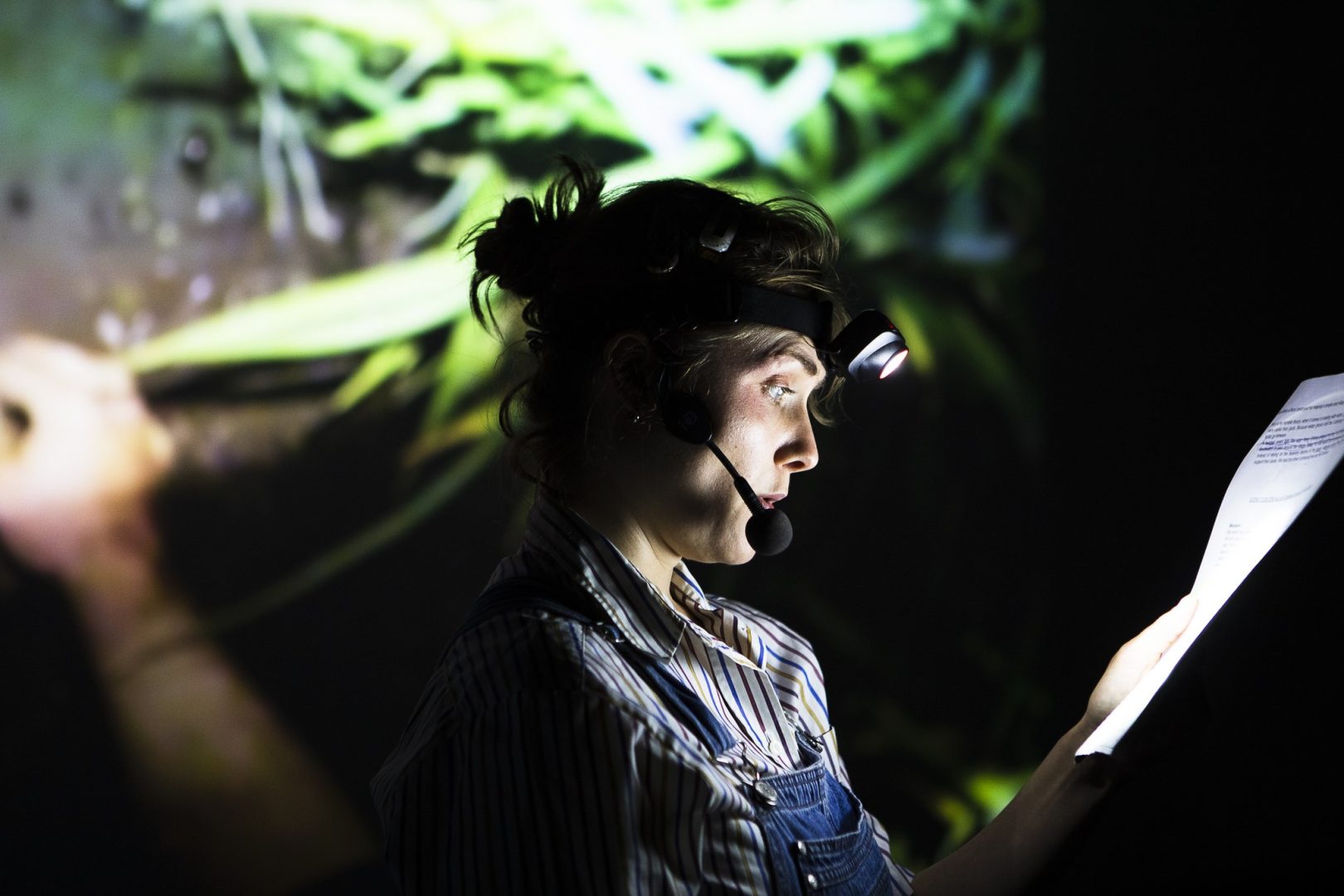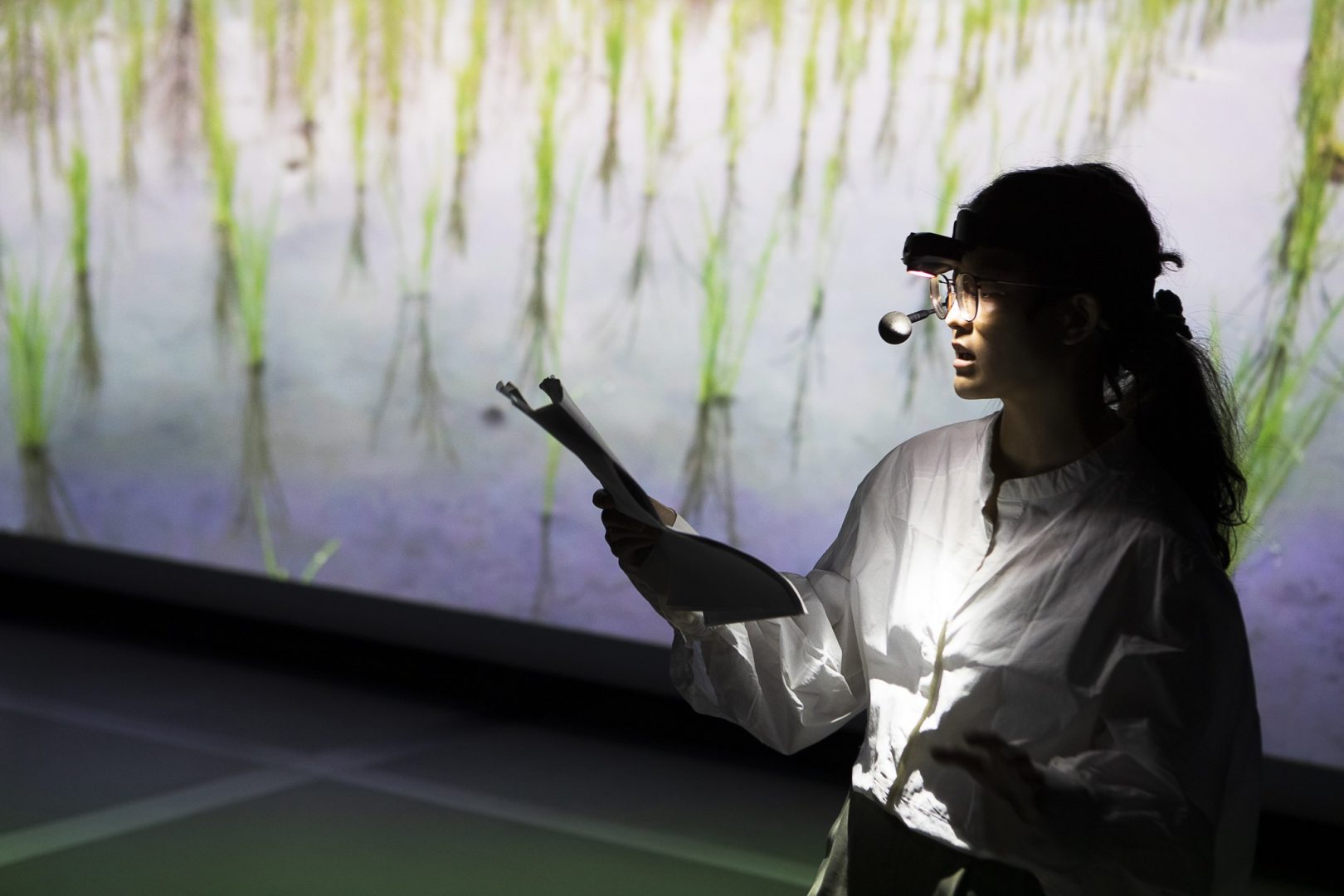Created as a collaboration between anthropologists Yen-Ling Tsai and Anna Lowenhaupt Tsing, filmmaker Isabelle Carbonell, and farmer and translator Joelle Chevrier, the Golden Snail Opera is a multispecies enactment of experimental natural history. The golden treasure snail, first imported to Taiwan from Argentina in 1979 to start an escargot industry, is now a major pest for rice agriculture. While pesticides are often used in their extermination, a new generation of friendly farmers in Taiwan’s Yilan County hand-pick the snails and integrate them within the ecology of the rice paddy.
Yilan is also the home of Taiwanese opera, o-pei-la, a form of entertainment that is grassroots, amateur, and infused with a queer sensibility. Golden Snail Opera incorporates percussion from Yilan opera, combining it with the noises of snails, water, birds, and other beings. Rather than just forming an accompaniment, the sounds engage in a dialogue with the script, which combines material from interviews, participant observation, and imagination. Through video and text, various beings of the rice fields offer an enactment of harmonious coexistence.
For Helsinki Biennial 2023, screenings with live performance readings of the Golden Snail Opera were staged in June and August 2023 at Helsinki Central Library Oodi.
Yen-Ling, who is teaching anthropology in Taiwan, has a deep, historically rich, and familial connection to the land, and years of hands-on direct experience with rice farming that allowed for a unique set of observations from which the seeds of the project arose. Yen-Ling and Joelle both work long hours every day in the rice paddy: whether planting rice, weeding, trying to make scarecrows for the birds, unknowingly interacting with the paddy ghosts, collecting the daily influx of golden apple snails by hand, or eventually harvesting the rice. In addition, they are both part of a larger farming community of old and young, that combines generations of experience with rice, water, weather, offerings to the ghosts, snails and other creatures, with more modern experimental techniques. Anna, who has decades of experience investigating, practicing, theorizing and writing about different attunements to multispecies life, not only acted as the initial connector between us all but also catalyzed a unique collaboration.
As a PhD student, my research and practice were – and still are – at the intersection of expanded documentary, environmental justice, and the Anthropocene, while striving to develop new visual and sonic approaches and methods to rethink documentary filmmaking and create a multispecies cinema. I flew in for an intense two weeks of filming, ready for a number of different shooting scenarios. Though I enacted traditional documentary filmmaking techniques, such as interviewing humans, I also experimented with other ideas, such as using a spy camera on the back of a snail. The piece came together afterwards in an iterative manner: while I was editing small pearls of the film to share with the rest of the team, Anna, Yen-Ling, and Joelle were writing and experimenting with the text. While editing, I realized more set-ups I wished to try even though I was no longer in Taiwan; Joelle volunteered to try her hand at filming, and she and I worked closely to create more footage. We all inspired each other, a type of call and response back-and-forth. This wide, collaborative web of relations formed the basis for our opportunity to attune beyond the human, acknowledging the pluriverse of the paddy.
Excerpt adapted from Isabelle Carbonell’s PhD dissertation, Attuning to the Pluriverse: Documentary Filmmaking Methods, Environmental Disasters, & The More-Than-Human

© HAM/Helsinki Biennial/Kirsi Halkola

© HAM/Helsinki Biennial/Kirsi Halkola

© HAM/Helsinki Biennial/Kirsi Halkola
Golden Snail Opera
2016
video, performance-oriented text
Authors: Yen-ling Tsai 蔡晏霖, Isabelle Carbonell, Joelle Chevrier 蔡雪青, Anna Tsing 安清
Director of Photography, Sound Design, and Editor: Isabelle Carbonell
Producer: Kaohsiung 147 Japonica Rice (Oryza sativa) 高雄147香米
Cinematography:
Isabelle Carbonell (Homo sapiens) Canon 5D, Sony A7rii
Joelle Chevrier (Homo sapiens) Sony cyber-shot, Brinno TLC200, GoPro on head
Hua Fu (Canis lupus familiaris) GoPro camera strapped to back
Giant African Snail (Achatina fulica) Microcamera affixed with Velcro
Muscovy duck (Cairina moschata) Microcamera attached to neck
Bamboo post (stand in for weight challenged Oryza sativa) GoPro, Brinno TLC200
廖丹華 Frances Liao (Homo sapiens) GoPro on chest
Sound:
Giant African Snail (Achatina fulica)
Golden Apple Snail (Pomacea Canaliculata)
Isabelle Carbonell
蔡晏霖 Yen-ling Tsai
Joelle Chevrier 蔡雪青
蘭陽戲劇團 Lanyang Opera
Taiwan Production Assistant:
廖丹華 Frances Liao
廖芷瑩 & 郭沛軒
Translators:
Joelle Chevrier 蔡雪青
廖丹華 Frances Liao & 黃思瑜 & 曾詩涵
Thank you:
三官大帝 & 老大公好兄弟, 陳榮昌, 朱美橋, 莊福清, 三官宮營膳組阿姨們, 土拉客實驗農家園 Land Dyke Farm, 吳紹文 Shawn Wu, 洪鳳琴, 黃思瑜, 農田裡的科學計畫 Science in Field, 林芳儀 Fangyee Lee, 陳毅翰 Ihan Chen, 陳曉默 Mose Chen, 游麗花, 游花福 Huafu the Dog, 宜蘭社區大學 Ilan Community College, 綠色工作研習計畫水稻班, 邱靖惠, 波波的稻米, 楊鈴子, 國立宜蘭大學海洋資源研究室 Marine Resources Lab at National Ilan University, 陳永松 Yung-song Chen, 陳泓文, 陳福安, Tating Susilawati, 穀東俱樂部, 吳佳玲, 黃京國, 林欣琦, Mathilde Højrup, Meredith Root-Bernstein, The Cornell Lab of Ornithology, Nicholas Navin Microscopy, Cold Spring Harbor Laboratory, New Scientist, Ryan Page, Steven Trimmer, Anna Friz, Irene Lusztig, Team members of Aarhus University Research on the Anthropocene, Nils Bubandt, Bruno Latour, Isabelle Stengers, Jennifer Deger, and Four anonymous reviewers
The Golden Snail Opera team is grateful to Cymene Howe, liaison with Cultural Anthropology. Filming in Taiwan was made possible by a University of California Graduate Student Association Travel Award, as well as support from Aarhus University Research on the Anthropocene (funded by the Danish National Research Foundation). Field research and writing was funded by the Ministry of Science and Technology, Taiwan, and supported by the Institute of Yilan County History.
Courtesy of the artists.
Performers for Helsinki Biennial edition: Students of Live Art and Performance Studies (MA) at University of the Arts Helsinki’s Theatre Academy: Stefanía Ólafsdóttir, Ladapha ‘Tangmo’ Sophonkunkit and Tina Jeranko.
Directing assistance for Helsinki Biennial edition: Tuuli-Mariia Nilsson, Lecturer, Degree Programme in Acting, Theatre Academy.
Location:
Central Library Oodi, venue Maijansali
Töölönlahdenkatu 4
Oodi and Maijansali are accessible, read more here.
Performances
Mon 12.6. at 13:00
Mon 12.6. at 18:00
Wed 9.8. at 13:00
Wed 9.8. at 18:00
Thu 10.8. at 13:00
Thu 10.8. at 18:00
The performance is free of charge. Register to attend here.
Duration of the performance: approx. 1 hour.
Language: English. A script in English and Finnish will be available on this website during performance period.
The script in English:
Download Golden Snail Opera Article and Script here